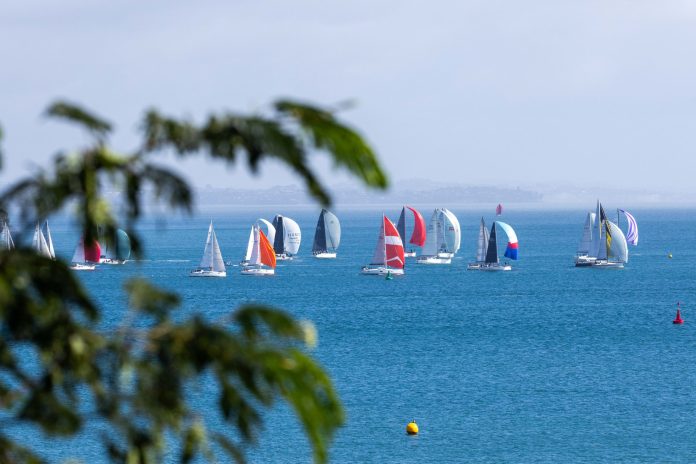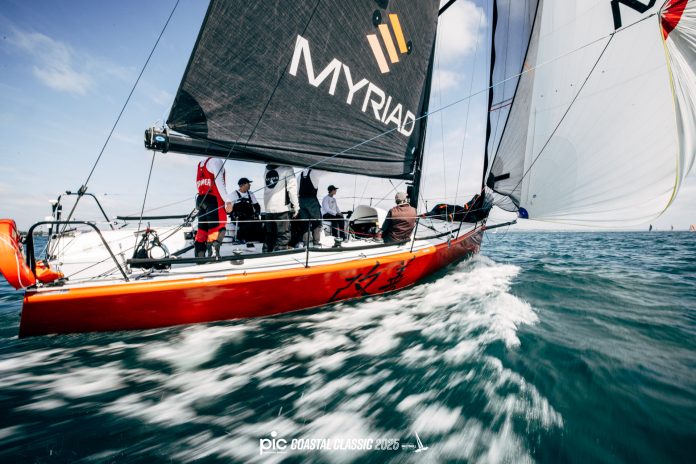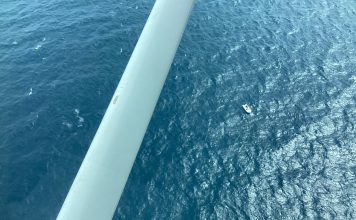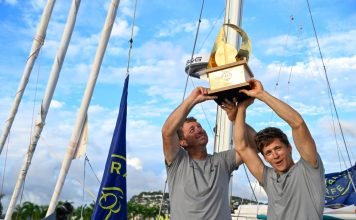Since 1982 this Labour Weekend drag race has forged legends, broken boats, and redefined what Kiwis mean by a quick trip north. The 2025 PIC Coastal Classic remains one of the most watched and best loved events on the sailing calendar, a 119 nautical mile sprint from Devonport Wharf to Russell Wharf. It is a race where innovation, seamanship, and sheer determination collide, and every year brings fresh surprises.
A race with history
The first Coastal Classic set off in 1982, the brainchild of Roger Dilley and the Auckland Multihull Sailing Association. A dozen boats took the start, from the 62 foot Fidelis to a 24 foot trimaran called Gulf Chariot. Krisis, skippered by Duncan Stuart, claimed the inaugural line honours in 18 hours.
That opening edition established the race’s DNA, fast, direct, and dramatic. Through the 1980s and 1990s fleets grew to more than 200 yachts, with revolutionary designs like Split Enz and Afterburner rewriting expectations of coastal speed. Legends of the sport cut their teeth here too. Sir Peter Blake raced aboard Krisis in 1987, while future America’s Cup names tested themselves off Cape Brett.
Records have been the heartbeat of the event. Alfa Romeo stunned onlookers in 2009 with 6 hours 43 minutes. Team Vodafone Sailing went one better in 2011, breaking the six hour mark at 5 hours 44 minutes. By 2014 the same boat (rebranded in 2016 as Frank Racing) lowered it again to 5 hours 13 minutes, a mark that still stands.
Rewind to 2024
Last year reminded everyone why the Coastal Classic is never predictable. Over fifty yachts crossed the line at Devonport, from grand prix multis to family campaigners. Early drama came when the restored Formula 40 Fat Freddy grabbed the lead to Sail Rock, then retired with beam damage. Highline, another strong hope, also withdrew.
That left the Rapido 60 trimaran Romanza to control the night run north. Skippered by Dougall Love, she crossed at an elapsed time of 14:46:45 to secure line honours. Levity, a Schionning CM46 catamaran, followed at 17:18:54, with Equilibrium, a Marten 55 Botin Carkeek monohull, close behind. Clockwork, Zephyrus, and the iconic Steinlager II rounded out the top group. On handicap, the beautifully built Warwick 50 Fez stole the spotlight, proving smart sailing can beat raw pace. Of the starters, only 39 finished, underlining the race’s toughness.
Previewing 2025
The 2025 PIC Coastal Classic begins on Friday 24 October, with a skipper’s briefing at the Royal New Zealand Yacht Squadron the night before. Three start sequences are planned off Devonport. Divisions 4, 5, 8, and Solo start at 0930. Divisions 2 and 3 start at 0945. Divisions 1, 6, and 7 start at 1000.
The course remains simple and unforgiving. Leave Devonport, turn north, and keep both Little Barrier Island and the Poor Knights to starboard. Thread Cape Brett, then charge into the Bay of Islands for the run to Russell Wharf. The finish cut off is 1400 on Saturday.
Divisions are broad enough to give every style of boat its own battle. Monohulls are split by size, multihulls by length, with a No Extras division for main and headsail only. Add ons include IRC, Classic, Women’s, Two Handed, and Solo, plus popular class groups such as Farr 1020s, Young 88s, and Open 8.5 multihulls.
Rally your way north
Not everyone wants to push the red line north. For 2025 the organisers have introduced a refreshed PIC Coastal Classic Rally format, supported by new sponsor Charlie Bravo Boat Co.
Two options bring cruisers into the story. Sailors can cruise north on Friday with the race fleet direct to Russell. Or they can depart on Thursday, stop overnight at Marsden Cove with berths and a social gathering, then rejoin on Friday for the final leg. Rally entries also require Cat 3 certification. It is an inclusive addition that captures the spirit of participation as much as competition, and it fits the Coastal’s community heart.
Weather, tactics, and the Brett factor
Labour Weekend weather demands respect. Strategy often hinges on timing the seabreeze against the gradient, and on when to shift modes as the Gulf transitions. The three checkpoints, Flat Rock, Sail Rock, and Cape Brett, test crews in different ways. Cape Brett in particular is infamous as a parking lot, where promising leads fade in dead air and patient rivalries flip in minutes.
Success depends on threading a line between risk and reward. Some go offshore to hunt pressure and leverage, others hug the coast for cover and clear lanes. At night, keeping the boat at full potential while avoiding traps is the craft that decides a Coastal. For cruisers in the rally, the Marsden Cove stop offers rest and a tidy jump on the morning breeze before the charge to Russell.
A promise north
The 2025 PIC Coastal Classic is set to deliver another chapter in New Zealand’s coastal sailing story. The boats may be faster, the trackers digital, and the safety rules sharper, yet the spirit remains the same.























